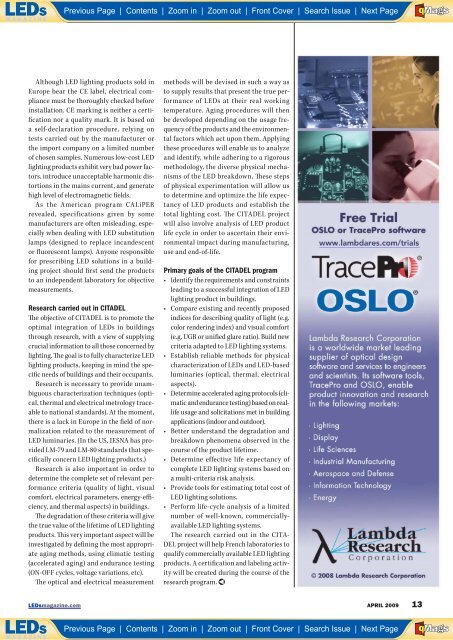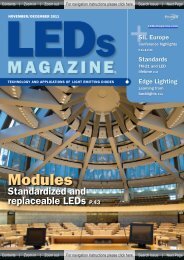Previous Page | Contents | <strong>Zoom</strong> in | <strong>Zoom</strong> out | Front Cover | Search Issue | Next PageABE FMaGSfundingprogramsCITADEL key parametersPROJECT BUDGET: 1.5 million Euros (~$2M)FUNDING: ADEME (French Environmental Agency)START DATE: 9 February 2009DURATION: 3 yearsMORE DETAILS: ledsmagazine.com/news/6/2/14French CITADEL project looks atLED lighting in buildingsThe research will help French laboratories to qualify commerciallyavailable LED lighting products, writes CHRISTOPHE MARTINSONS.Currently the field of lighting is in the midstof a technological revolution, unique in itshistory, with the advent of new generationsof systems based on LEDs. Significant progressachieved by semiconductor specialistshas led to robust and compact light sources,offering attractive control capabilities. <strong>In</strong>laboratory conditions, white LEDs reachluminous efficacies greater than those ofmost lamps used in lighting, and, above all,they exhibit far greater life expectancy. LEDsare therefore considered, as they well shouldbe, as a major component in future solutionsfor interior and exterior lighting.Despite all these advantages enthusiasticallyput forward by the semiconductorindustry, it is commonly reported that theuse of LEDs in buildings is slowed down by acertain number of complicated problems. Therequirements for successful building integrationare very specific and often unrecognizedby LED makers. Several constraints occur inbuilding applications: visual comfort, performancesustainability over time, real-lifeexpectancy, total cost assessment, and compliancewith building standards and codes.LED lighting products should be ableto fulfill the fundamental requirementsdescribed in well-established EuropeanCHRISTOPHE MARTINSONS is head of theLighting, Electricity and ElectromagnetismDivision of CSTB, St Martin d’Hères, France.Email: christophe.martinsons@cstb.fr.lighting standards such as EN 12464-1 forindoor lighting of work places. For instance,LEDs should provide the required “qualityof light” that is associated with a minimumcolor rendering index and a range of colortemperature.Glare is a critical phenomenon often associatedwith the use of LEDs. Satisfying conditionsof visual comfort cannot be reachedwhen sources of very high luminance are inthe field of view. This is the case for “naked”high power LEDs with luminance levels measuredin millions of cd/m2 (nit). Naked LEDsor LED arrays (products with insufficientoptical design) may present visual risks.Safer products with better optical designscan still exhibit discomfort glare, which isnot very well characterized by the standardUGR (unified glare ratio). Its calculationmethod fails when applied to a multitude ofsource points such as an LED array.LED products are very thermally sensitive.LED junction temperature critically affectslight output and color, as well as life expectancy.Many LED products are designed tobe integrated in walls, ceilings or floors, andthese elements are often very well insulated(acoustically and thermally). This meansthat heat generated by LED products mightnot properly dissipate. Generated heat caneven endanger the integrity of building elements,causing for example cracking ofmaterials or deterioration of sealants, allowingmigration of humidity.CITADEL consortiumThe CITADEL consortium is formed byseveral public research laboratories, publicinstitutions and a major lighting company.The partners have complementaryskills and each specializes in a key aspectof LED lighting and building integration:CSTB: Centre Scientifique et Techniquedu Bâtiment (Centre for Building Scienceand Technology), Grenoble, France. Projectleader. <strong>In</strong> charge of photometry ofluminaires, building integration, agingprotocols, risk analyses and effective lifeexpectancy, life cycle analysis.LASH: Laboratoire des Sciences del’Habitat (ENTPE and CNRS), Lyon. Buildingintegration (visual aspects), light qualityindices, photo-realistic simulations,experiments on subjects, total cost ofownership.CEA-LETI: Grenoble. Microelectronicsexpertise on LEDs, degradation and breakdownsmechanisms of chips/packaging.LNE: Laboratoire National de Métrologieet d’Essais, Trappes. Traceability of measurements,design and construction of highpower LED standard devices.LAPLACE: University of Toulouse andCNRS, Toulouse. Expertise on electronicsaspects of LED lighting products (powersupply and controls). Accelerated aging ofLEDs and LED modules.Philips Lighting, Luminaire division, Miribel:Philips Lighting is committed to providingthe CITADEL partners with therequired product data (bill of materials,industrial processes, etc.) necessary to performlife-cycle analyses and environmentalimpact studies. ◀Footnote: CSTB, LNE, LAPLACE and Philips areactively involved in national and international normalizationactivities (AFNOR in France, CEN inEurope, CEI and CIE worldwide)12 APRIL 2009 LEDsmagazine.comPrevious Page | Contents | <strong>Zoom</strong> in | <strong>Zoom</strong> out | Front Cover | Search Issue | Next PageABE FMaGS
Previous Page | Contents | <strong>Zoom</strong> in | <strong>Zoom</strong> out | Front Cover | Search Issue | Next PageABE FMaGSAlthough LED lighting products sold inEurope bear the CE label, electrical compliancemust be thoroughly checked beforeinstallation. CE marking is neither a certificationnor a quality mark. It is based ona self-declaration procedure, relying ontests carried out by the manufacturer orthe import company on a limited numberof chosen samples. Numerous low-cost LEDlighting products exhibit very bad power factors,introduce unacceptable harmonic distortionsin the mains current, and generatehigh level of electromagnetic fields.As the American program CALiPERrevealed, specifications given by somemanufacturers are often misleading, especiallywhen dealing with LED substitutionlamps (designed to replace incandescentor fluorescent lamps). Anyone responsiblefor prescribing LED solutions in a buildingproject should first send the productsto an independent laboratory for objectivemeasurements.Research carried out in CITADELThe objective of CITADEL is to promote theoptimal integration of LEDs in buildingsthrough research, with a view of supplyingcrucial information to all those concerned bylighting. The goal is to fully characterize LEDlighting products, keeping in mind the specificneeds of buildings and their occupants.Research is necessary to provide unambiguouscharacterization techniques (optical,thermal and electrical metrology traceableto national standards). At the moment,there is a lack in Europe in the field of normalizationrelated to the measurement ofLED luminaries. (<strong>In</strong> the US, IESNA has providedLM-79 and LM-80 standards that specificallyconcern LED lighting products.)Research is also important in order todetermine the complete set of relevant performancecriteria (quality of light, visualcomfort, electrical parameters, energy-efficiency,and thermal aspects) in buildings.The degradation of these criteria will givethe true value of the lifetime of LED lightingproducts. This very important aspect will beinvestigated by defining the most appropriateaging methods, using climatic testing(accelerated aging) and endurance testing(ON-OFF cycles, voltage variations, etc).The optical and electrical measurementmethods will be devised in such a way asto supply results that present the true performanceof LEDs at their real workingtemperature. Aging procedures will thenbe developed depending on the usage frequencyof the products and the environmentalfactors which act upon them. Applyingthese procedures will enable us to analyzeand identify, while adhering to a rigorousmethodology, the diverse physical mechanismsof the LED breakdown. These stepsof physical experimentation will allow usto determine and optimize the life expectancyof LED products and establish thetotal lighting cost. The CITADEL projectwill also involve analysis of LED productlife cycle in order to ascertain their environmentalimpact during manufacturing,use and end-of-life.Primary goals of the CITADEL program• Identify the requirements and constraintsleading to a successful integration of LEDlighting product in buildings.• Compare existing and recently proposedindices for describing quality of light (e.g.color rendering index) and visual comfort(e.g. UGR or unified glare ratio). Build newcriteria adapted to LED lighting systems.• Establish reliable methods for physicalcharacterization of LEDs and LED-basedluminaries (optical, thermal, electricalaspects).• Determine accelerated aging protocols (climaticand endurance testing) based on reallifeusage and solicitations met in buildingapplications (indoor and outdoor).• Better understand the degradation andbreakdown phenomena observed in thecourse of the product lifetime.• Determine effective life expectancy ofcomplete LED lighting systems based ona multi-criteria risk analysis.• Provide tools for estimating total cost ofLED lighting solutions.• Perform life-cycle analysis of a limitednumber of well-known, commerciallyavailableLED lighting systems.The research carried out in the CITA-DEL project will help French laboratories toqualify commercially available LED lightingproducts. A certification and labeling activitywill be created during the course of theresearch program._____________________LEDsmagazine.com APRIL 2009 13Previous Page | Contents | <strong>Zoom</strong> in | <strong>Zoom</strong> out | Front Cover | Search Issue | Next PageABE FMaGS

















